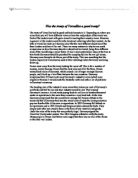How significant was the Treaty of Versailles as a factor in explaining the German hyperinflation of 1923?
In 1923, Germany saw a rapid increase in inflation which reached unprecedented levels. In January of that year, one US Dollar was equal to 17,792 Marks, but by November a Dollar was equal to 200,000,000,000 Marks. This was the highest rate of inflation ever seen and had far reaching social as well as economic consequences. The causes of this “hyperinflation” have been widely debated.
Most people at the time placed the blame solely on the harsh terms of the Treaty of Versailles. This was the treaty agreed by the allies and Germany to end the First World War, although Germany had little say in the matter. Germany was forced to pay reparations to the allies for damage caused during the war. The final amount was set at £6,600m. In order to pay this, and pay for post-war reconstruction in Germany, the German government printed off more and more money, which in turn led to hyperinflation. Also, some of Germany’s key industrial zones were occupied causing inflation to “spiral out of control”.







